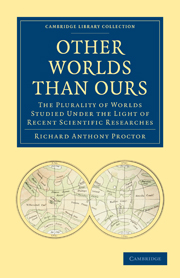 Other Worlds Than Ours
Other Worlds Than Ours Book contents
- Frontmatter
- Preface
- Contents
- ILLUSTRATIONS
- INTRODUCTION
- CHAP. I WHAT THE EARTH TEACHES US
- CHAP. II WHAT WE LEARN FROM THE SUN
- CHAP. III THE INFERIOR PLANETS
- CHAP. IV MARS, THE MINIATURE OF OUR EARTH
- CHAP. V JUPITER, THE GIANT OF THE SOLAR SYSTEM
- CHAP. VI SATURN, THE RINGED WORLD
- CHAP. VII URANUS AND NEPTUNE, THE ARCTIC PLANETS
- CHAP. VIII THE MOON AND OTHER SATELLITES
- CHAP. IX METEORS AND COMETS; THEIR OFFICE IN THE SOLAR SYSTEM
- CHAP. X OTHER SUNS THAN OURS
- CHAP. XI OF MINOR STARS, AND OF THE DISTRIBUTION OF STARS IN SPACE
- CHAP. XII THE NEBULÆ, ARE THEY EXTERNAL GALAXIES?
- CHAP. XIII SUPERVISION AND CONTROL
- Plate section
CHAP. I - WHAT THE EARTH TEACHES US
Published online by Cambridge University Press: 05 July 2011
- Frontmatter
- Preface
- Contents
- ILLUSTRATIONS
- INTRODUCTION
- CHAP. I WHAT THE EARTH TEACHES US
- CHAP. II WHAT WE LEARN FROM THE SUN
- CHAP. III THE INFERIOR PLANETS
- CHAP. IV MARS, THE MINIATURE OF OUR EARTH
- CHAP. V JUPITER, THE GIANT OF THE SOLAR SYSTEM
- CHAP. VI SATURN, THE RINGED WORLD
- CHAP. VII URANUS AND NEPTUNE, THE ARCTIC PLANETS
- CHAP. VIII THE MOON AND OTHER SATELLITES
- CHAP. IX METEORS AND COMETS; THEIR OFFICE IN THE SOLAR SYSTEM
- CHAP. X OTHER SUNS THAN OURS
- CHAP. XI OF MINOR STARS, AND OF THE DISTRIBUTION OF STARS IN SPACE
- CHAP. XII THE NEBULÆ, ARE THEY EXTERNAL GALAXIES?
- CHAP. XIII SUPERVISION AND CONTROL
- Plate section
Summary
Before proceeding to consider the various circumstances under which the worlds or systems which surround us appear to subsist, it may be well to inquire how far we have reason to conclude, from the consideration of our own earth and its inhabitants, that the Creator has designed the orbs which exist throughout space for the support of living creatures.
It would not be just to argue directly from the fact that the earth is inhabited to the conclusion that the other planets are inhabited also, nor thence to the conclusion that other stars have, like our sun, their attendant worlds, peopled with various forms of life. An analogy founded on a single instance has no logical force. And it is doubtful whether we have not, in the moon, an instance which would as effectually serve to support a directly opposite conclusion. It seems all but certain, as we shall presently have occasion to show, that no part of the moon's globe is inhabited by living creatures. Certainly she is inhabited by none which bear the least resemblance to those existing on our earth. Thus it might fairly be urged, that since one of the two orbs respecting which we know most appears to be uninhabited, there remains no probable argument in favour of the view that other orbs besides our earth are the abode of living creatures.
- Type
- Chapter
- Information
- Other Worlds Than OursThe Plurality of Worlds Studied under the Light of Recent Scientific Researches, pp. 7 - 19Publisher: Cambridge University PressPrint publication year: 2009First published in: 1870


